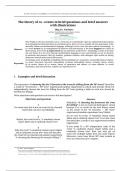Exam (elaborations)
The theory of co∼events in brief questions and brief answers with illustrations
- Course
- Institution
For some taste this is not an event (in the classical sense) that can have a probability. Definitely! “A choosing (by foresters) the trees for felling” is not an event (in Kolmogorov sense) because it is co∼event (in the new theory sense) as the result of the “15 foresters × 387 trees...
[Show more]



